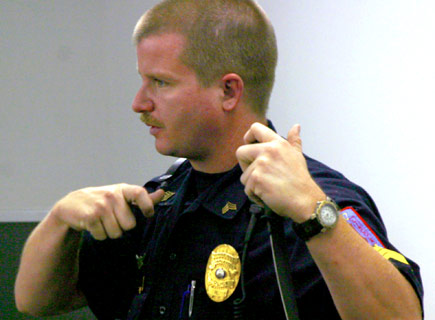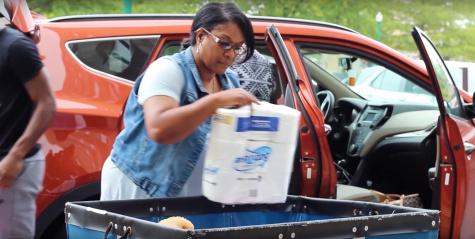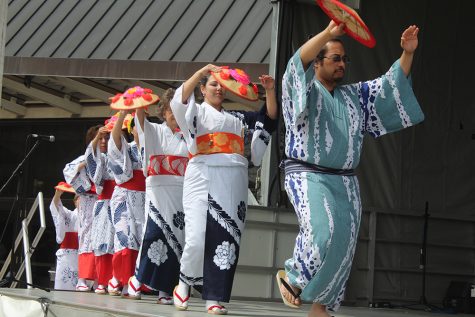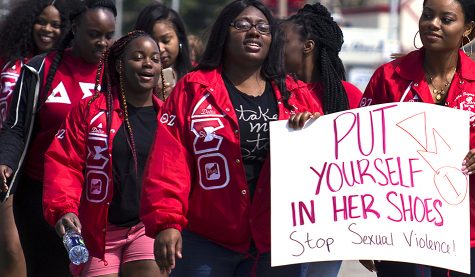Citizens Policy Academy Week 2
Editor’s Note: This is the second article in a 15-part weekly series detailing Associate Online Editor Adam Testa’s experiences in Charleston’s Citizens Police Academy program.
Never bring a knife to a gunfight.
Or so that’s how the old saying goes, but at Thursday’s meeting of Citizens Police Academy, I learned how wrong the old adage is.
The night’s lectures on how lethal and dangerous a person with a knife can be really opened my eyes to a whole side of things I had never thought of before.
“The more you know about knives, the scarier they become,” said Sgt. John Bennett, our defensive tactics teacher for the session.
First of all, not every person has a gun in his or her home, but you would be hard pressed to find a home without a knife. This basically means that every person has access to a deadly weapon.
Sgt. Brad Oyer talked to our class about the dangers of knives in close range combat and demonstrated knife attacks and ways to attempt to defend oneself.
In close range combat, a knife is a much deadlier weapon that a firearm.
With a firearm, there are only two ways to stop someone completely. The first is to bleed them out, or cause them to lose blood until they lose consciousness or eventually die. The other is to have a direct hit in the central nervous system, which is the area in a triangle shape around the nose.
With a knife, the risk is much higher and the process much faster, especially if someone manages to hit an artery.
“An arterial cut with a knife can cause unconsciousness in second,” Oyer said. Death can soon follow, too. With a gunshot, it may take minutes.
One reason that police officers have to learn to defend themselves from knives is that in close range situation where an assailant is armed with a knife, the officer may not even have time to pull their gun and fire before the assailant is rushing them.
All officers are trained in defending themselves from knife attacks as a part of their training.
Another aspect of defensive tactics we learned Thursday night was the Cooper Color Codes of Mental States.
Cooper’s Codes assign different colors to different statuses of awareness, ranging from white to black.
People who are in the White Stage are people who are not watching their surroundings or paying attention to where they are going. People in White are the most likely to be victims of crime.
“People walking down the street looking at their feet are more vulnerable,” Oyer said.
Oyer taught us that people in White often become the unsuspecting, easy targets for people looking for a victim.
Many people are in White when they are driving, which causes a majority of the traffic accidents on the highway. Also, people often slip into White when they are jogging or running and they have music playing in their headphones.
“You can’t hear the car coming,” Oyer said. “You can’t hear the car honking at you.”
Yellow is the next stage after White, and in Yellow, a person is alert to their surroundings and aware of what is going on. Most people are in Yellow 99 percent of the time.
Orange and Red are the next two stages where one considers taking action and then actually takes it.
Black is the final stage. Black Stage can basically be described as the “deer in headlights” stage, Oyer said. At this point, the person is in a complete state of panic and is unable to take action.
The lecture really hit home to me because it made me realize that half the time I am walking around and driving, I am in White stage. I now realize that this is potentially dangerous and that I really need to begin paying attention to my surroundings more.
I highly suggest that everyone else try to do the same. By just paying attention to what is going on around us, we can make ourselves much safer.
After Thursday’s session of Citizens Police Academy, all 10 participants there agreed that we had more respect for the work that police officers do. If all citizens could complete the program, it would probably have the same effect on all of them too.
Citizens Policy Academy Week 2

Sgt. Brad Oyer of the Charleston police department demonstrates on how knoves can be more dangerous and potentially deadly than handguns at close range at the Citzen’s Policy Academy on Thursday evening. (Jay Grabiec/The Daily Eastern News)








































